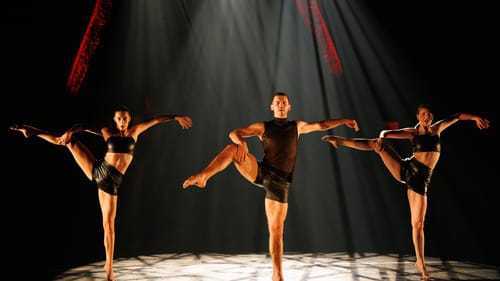Stay in the Loop
BSR publishes on a weekly schedule, with an email newsletter every Wednesday and Thursday morning. There’s no paywall, and subscribing is always free.
Expansive themes in dance
Koresh Dance Company presents Hollow Apple

Koresh Dance Company’s Hollow Apple tackled a timely, social-media-worthy subject while incorporating familiar and new elements for the company. Its signature style and energetic, aggressive movement combined with music and poetry by Sage DeAgro-Ruopp and Karl Mullen, who have collaborated with artistic director and choreographer Ronen Koresh before. But Hollow Apple seemed to take on new topics in exploring the tension between the human fear of unworthiness and the drive for acceptance or approval.
The program began with the Koresh Youth Ensemble performing Awaken by Melissa Rector, a Koresh dancer who serves as the company’s assistant artistic director as well as director of the youth ensemble. The young dancers were terrific in this fast-paced and complicated work that matched technical complexity with emotional depth. The mood and tone shifted as often as level, tempo, and formation. The whole ensemble tore off their tops and threw them, then paired clasped hands and balanced. The dancers’ hand gestures and long red skirts recalled One Thousand and One Nights, Rector’s project with Jim Bunting. Beautifully lit throughout by Alyssandra Docherty, who also designed the lighting for Hollow Apple, Awaken concluded with the illusion of dancers disappearing into darkness at the back of the stage.
Missed connections and techno-paranoia
Koresh’s Hollow Apple began with similarly striking images. The full company danced a synchronous section that included big gestures, leaping, and running. A few flowing, ballet-like moves added grace to movement that tended toward urgency and aggression. Dancers clapped their hands, clutched their sides, and pumped their elbows with their hands clasped behind their necks.
These gestures recurred throughout the work, which had a futuristic, dystopian feel enhanced by the red and white palette of Docherty’s lighting. Original music by DeAgro-Ruopp layered instruments and industrial sounds over steady beats, with a bit of bhangra and circus organ. Mullen’s disembodied voice drifted in and out as he recited lines about a mirror. The effect suggested techno-paranoia, while costumes by Koresh and Alicia Tom invoked a potentially post-gender future. Perhaps they also reflected how the need to be liked transcends gender.
Hollow Apple used gesture and movement to depict the impact of its themes. Rector guided the viewer through the work as she portrayed a person struggling with self-image and connection to others. Several times she seemed trapped inside a circle formed by moving, writhing bodies. At other points, she was an outsider who stood alone to watch.

At its best, Hollow Apple conveyed the trapped, desperate feeling of conflicting impulses. The performers mimed swimming and stuffing their faces with food. Later, they brought a hand to their mouths before throwing their open palms into the air (a gesture of voicelessness also evoking One Thousand and One Nights). In Hollow Apple, Rector jumped against a wall of bodies that thwarted her movement or escape. Devon Larcher, Sarah Shaulis, Paige Devitt, Callie Hocter, Savanna Mitchell, Mia Davis, and Owen Whetstone shone in a section suggesting kinetic feedback loops. Their high kicks punctuated tango and waltz-like steps that kept them moving while going nowhere.
Mixed artistic delivery
Hollow Apple marks Koresh Dance Company’s continuing engagement with expansive themes. In 2023, it presented a show about masks and masquerades. That topic has unique implications in the digital era, and Hollow Apple’s themes felt even more relevant. Although the show did not reference social media, it brought to mind the need to be liked online and how technologies can thwart the connections they facilitate. However, the work’s treatment of its themes was opaque and ultimately unsatisfying. The program listed 11 discrete sections, but they were hard to identify despite each having a unique (and often ponderous) title. And as in 2023’s Masquerade, the second act was much shorter and slightly less cohesive.
But other viewers may not find fault with these features. I place high value upon the delivery of artistic promises, which doesn’t make Hollow Apple a deceptive treat. Rather, it may be a matter of personal preference. Regardless, Hollow Apple was interesting and well-danced. Koresh’s layered choreography incorporated Rector’s movement vocabulary to thought-provoking and engrossing effect.
What, When, Where
Hollow Apple. Choreography by Melissa Rector and Ronen Koresh. Koresh Dance Company. April 25-28, 2024, at the Suzanne Roberts Theatre, 480 S Broad Street, Philadelphia. (215) 751-0959 or koreshdance.org.
Accessibility
Suzanne Roberts Theatre is a wheelchair-accessible venue.
Sign up for our newsletter
All of the week's new articles, all in one place. Sign up for the free weekly BSR newsletters, and don't miss a conversation.

 Melissa Strong
Melissa Strong